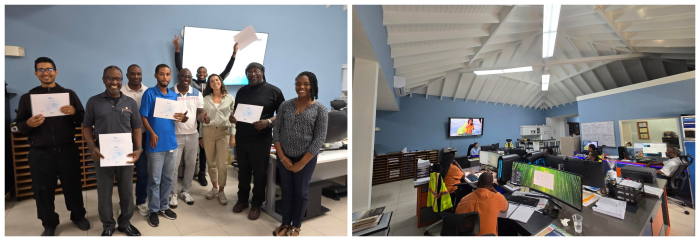 PHILIPSBURG:--- Kadaster St. Maarten is now officially GIS Ready, following the deployment of its in-house Geographic Information System (GIS) platform. This milestone reinforces Kadaster’s commitment to digital transformation, improved service delivery, and spatially enabled land administration.
PHILIPSBURG:--- Kadaster St. Maarten is now officially GIS Ready, following the deployment of its in-house Geographic Information System (GIS) platform. This milestone reinforces Kadaster’s commitment to digital transformation, improved service delivery, and spatially enabled land administration.
Developed in close collaboration with GIS4C B.V., the new system includes the implementation of ArcGIS Enterprise, ArcGIS Pro, Drone2Map, and on-premise GIS infrastructure. In addition to the technical setup, GIS4C also provided intensive training to cross-departmental staff, ensuring that the knowledge gained is embedded throughout the organization.
“This is a turning point for Kadaster,” said Managing Director Benjamin Ortega. “With our GIS foundation in place, we can now streamline internal operations, deliver more accurate spatial data, and support our clients including government, utility companies, legal entities, and the general public with modern digital services.”
As part of Kadaster’s commitment to youth development and knowledge-sharing, one student from Milton Peters College (MPC) who interned at Kadaster was invited to take part in the GIS training. The organization is actively exploring further collaborations with local schools and educational institutions to give more students hands-on exposure to GIS and how it can be integrated into new and emerging technologies.
The new GIS platform enhances Kadaster’s ability to visualize and analyze land parcel data in real time. It supports improved spatial planning and emergency response, and makes it possible to integrate geographic data directly into day-to-day workflows. The system also strengthens Kadaster’s capacity to collaborate with clients through dynamic, map-based services.
To better tailor these services, Kadaster is introducing a new approach to client segmentation based on GIS usage. “A Clients” include users who need view-only access to spatial data, such as notaries, law firms, and the general public. “B Clients” are those who require limited interaction with spatial datasets. “C Clients” include government agencies and technical partners who need full access to GIS capabilities for planning, analysis, and decision-making.
Kadaster’s GIS initiative is part of a broader strategy to modernize its digital services. In the coming months, the organization will introduce drone-based mapping and aerial data collection as a new tool for land surveying and analysis. Further training and capacity building efforts are also planned, along with the rollout of enhanced GIS-based services for the public. Kadaster is also seeking strategic partnerships with infrastructure and utility stakeholders to expand the use of GIS in national development.
A consultation process is currently underway to gather input from internal teams and external stakeholders. This feedback will help refine the GIS roadmap and ensure that the platform continues to evolve in line with service needs and the national vision for digital transformation.